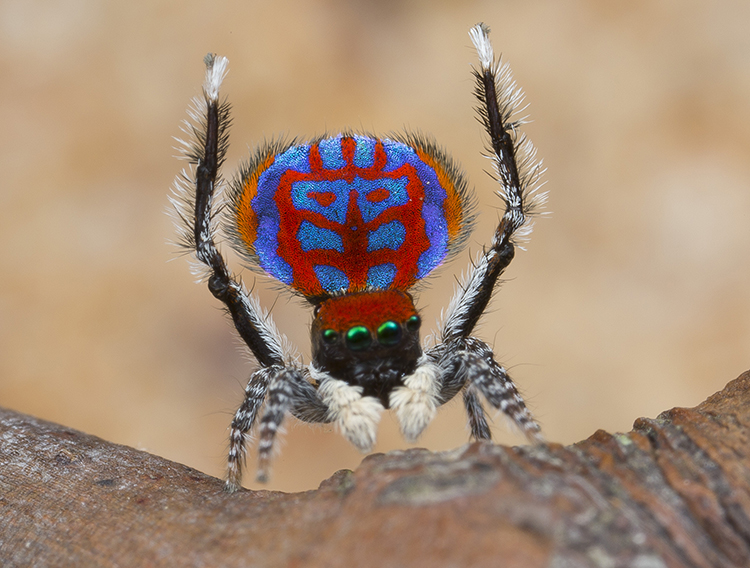Current Events Lesson Plan: June 9-22, 2016
Current Event: Australia’s Peacock Spider
Scientists recently discovered seven new species of peacock spiders. These tiny spiders with dazzling colors and fancy dance moves are found only in Australia and are less than a ¼ of an inch (6 millimeters) long. Males from these species are brightly colored and have elaborate rolling and shaking dances and displays to win over potential mates. A male peacock spider has to be careful, though: if the female is unimpressed, she may decide to eat him! Peacock spiders are jumping spiders. Jumping spiders do not spin webs; instead, they hunt by sneaking up and pouncing on their prey. These spiders have short legs, but they can jump more than 40 times the length of their bodies. Jurgen Otto, a German-born Australian scientist, discovered and helped name these new peacock spiders. He saw his first peacock spider in 2005, while he was on a family walk in Ku-ring-gai Chase National Park in New South Wales, near Sydney. Something flashy and small jumped in his path. After first spotting these spiders with jewel-colored tail flaps, it took him three years to find them again.

The brilliantly colored—but very tiny—Australian peacock spider is ready to dance. Credit: © Jurgen Otto
Objective:
Spiders are eight-legged animals that spin silk. Many spiders make silk webs, which are used to catch insects for food. All spiders have fangs, and all except a few have poison glands. Spiders use their fangs and poison glands to kill prey. A spider’s bite can paralyze or kill insects and other small animals. Spiders live anywhere they can find food. They thrive in fields, woods, swamps, caves, and deserts. One species spends most of life underwater. Many people think spiders are insects. However, spiders differ from insects in a number of ways. Insects have six legs, but spiders have eight. Most insects also have wings and antennae, but spiders do not. Biologists classify spiders as arachnids. Other arachnids include scorpions, ticks, and the spiderlike daddy longlegs. Tarantulas rank as the world’s largest spiders. The Behind the Headlines news story and related World Book articles explore spiders and other animals.
Words to know:
Discussion Topics:
1. Arachnophobia is the fear of spiders. Ask your students to name some other phobias. (Students might say acrophobia [fear of heights]; agoraphobia [dread of open spaces]; ailurophobia [fear of cats]; claustrophobia [fear of small spaces or being closed in]; glossophobia [fear of public speaking]; mysophobia [fear of dirt or germs]; ophidiophobia [fear of snakes]; triakaidekaphobia, also called triskaidekaphobia [fear of the number 13]; xenophobia [fear of foreigners or strangers]. Hopefully, your students didn’t have hippopotomonstrosesquipedaliophobia [fear of long words] when you asked them to answer this question.)
2. Ask your students why they think people are afraid of spiders.
3. Spider-Man is a popular superhero in American comics. Spider-Man is really a high school science student who was accidentally bitten by a radioactive spider, giving him superhuman powers. Ask your students what superhuman power they would choose to have if they could have one, and why.


